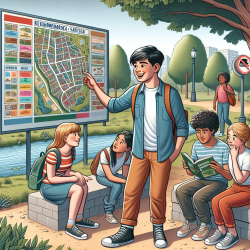Introduction
In the realm of adolescent development, understanding the factors that contribute to substance use is crucial for creating effective interventions. A recent study titled "Ecological Factors and Adolescent Marijuana Use: Results of a Prospective Study in Santiago, Chile" sheds light on how neighborhood characteristics can influence marijuana use among adolescents. This blog post aims to distill the findings of this study and offer insights for practitioners seeking to improve their skills and outcomes for children.
Key Findings from the Study
The study conducted in Santiago, Chile, involved 725 adolescents and explored the relationship between neighborhood characteristics and marijuana use. The researchers focused on three main neighborhood factors:
- Drug Availability: Higher levels of drug availability in neighborhoods were significantly associated with increased marijuana use among adolescents. This factor was identified as a critical predictor, with an odds ratio of 1.39, indicating a strong correlation.
- Crime: Contrary to common assumptions, general crime levels (e.g., muggings, burglaries) were not significantly linked to marijuana use.
- Noxious Environment: Factors such as trash, noise, and graffiti, although indicative of neighborhood disorder, did not show a significant direct impact on marijuana use.
Implications for Practitioners
The findings suggest that efforts to reduce adolescent marijuana use should focus specifically on reducing drug availability rather than general crime reduction or neighborhood beautification alone. Practitioners can consider the following strategies:
- Engage community members to monitor and report drug-related activities.
- Collaborate with local law enforcement to target drug trafficking and selling, especially near schools.
- Develop programs that increase parental awareness and involvement in monitoring adolescent activities.
- Promote after-school programs that provide safe and engaging environments for adolescents.
Encouraging Further Research
While the study provides valuable insights, it also highlights the need for further research. Practitioners are encouraged to explore the following areas:
- Investigate the mechanisms by which neighborhood drug availability influences adolescent behavior.
- Examine the role of peer and family influences in mitigating or exacerbating the impact of neighborhood factors.
- Explore interventions that have successfully reduced drug availability and assess their applicability in different contexts.
Conclusion
Understanding the distinct roles that different neighborhood factors play in adolescent marijuana use is essential for developing targeted and effective interventions. By focusing on reducing drug availability, practitioners can make a significant impact on adolescent health outcomes. For those interested in delving deeper into the research, the original study offers a comprehensive analysis of these dynamics.
To read the original research paper, please follow this link: Ecological Factors and Adolescent Marijuana Use: Results of a Prospective Study in Santiago, Chile.










